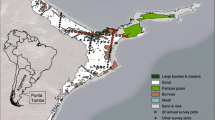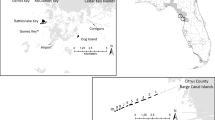Abstract
Nesting colonial waterbirds along the Atlantic Coast of the United States face a number of landscape-level threats including human disturbance, mammalian predator expansion, and habitat alteration. There have been changes from 1977 to the mid-1990s in use of nesting habitats and populations of a number of seabird species of concern in the region, including black skimmersRynchops niger Linnaeaus, common ternsSterna hirundo Linnaeaus, gull-billed ternsSterna nilotica Linnaeaus, least ternsSterna antillarum Lesson, royal ternsSterna maxima Boddaert, and sandwich ternsSterna sandvicensis Cabot. These species form colonies primarily on the following habitat types: large, sandy barrier or shoal islands, natural estuarine or bay islands (mostly marsh) man-made islands of dredged deposition materials (from navigation channels), and the mainland. Significant changes in the use of the dredged material islands have occurred for these species in New Jersey and North Carolina, but not in Virginia. Population declines and changes in bird habitat use appear to be at least partially associated with the conditions and management of the existing dredged material islands, coastal policy changes associated with creating new dredged material islands, and competing demands for sand for beach augmentation by coastal communities. As these and other coastal habitats become less suitable for colonial waterbirds, other man-made sites, such as, bridges and buildings have become increasingly more important. In regions with intense recreational demands, coastal wildlife managers need to take a more aggressive role in managing natural and man-made habitats areas and as stakeholders in the decision-making process involving dredged materials and beach sand allocation.
Similar content being viewed by others
Literature Cited
Buckley, F. G. andP. A. Buckley. 1980. Habitat selection and marine birds, p. 69–112.In J. Burger, B. Olla, and H. Winn (eds.), Behavior of Marine Animals, Volume 4: Marine Birds. Plenum Press, New York.
Burger, J. andM. G. Gochfeld. 1990. The Black Skimmer: Social Dynamics of a Colonial Species. Columbia University Press, New York.
Burger, J. andM. G. Gochfeld. 1991. The Common Tern: Its Breeding Biology and Social Behavior. Columbia University Press. New York.
Butler, R. W. andR. G. Vennesland. 2000. Integrating climate change and predation risk with wading bird conservation research in North America.Waterbirds 23:535–540.
Clark, J. R. 1991. Management of coastal barrier biosphere reserves.BioScience 41:331–336.
Croxall, J. P., P. G. H. Evans, andR. W. Schreiber (eds.), 1984. Status and Conservation of the World's Seabirds. International Council for Bird Preservation Technical Publication No. 2. ICBP. Cambridge, England.
Culliton, T. J., M. A. Warren, T. R. Goodspeed, D. G. Remer, C. M. Blackwell, andJ. J. McDonough, III 1990. Fifty years of population change along the nation's coasts 1960–2010. National Oceanic and Atmospheric Administration, National Ocean Service, Rockville, Maryland.
Erwin, R. M. 1979. Coastal waterbird colonies: Cape Elizabeth, Maine to Virginia. FWS/OBS 79/08. U.S. Fish and Wildlife Service. Washington, D.C.
Erwin, R. M. 1980. Breeding habitat use by colonially nesting waterbirds in two mid-Atlantic U.S. regions under different regimes of human disturbance.Biological Conservation 18:39–51.
Erwin, R. M. 1996. Dependence of waterbirds and shorebirds on shallow-water habitats in the mid-Atlantic coastal region: An ecological profile and management recommendations.Estuaries 19:213–219.
Erwin, R. M. andC. E. Korschgen. 1979. Coastal waterbird colonies: Maine to Virginia, 1977—An atlas showing colony locations and species composition. FWS/OBS 79/10. U.S. Fish and Wildlife Service, Washington, D.C.
Erwin, R. M., J. D. Nichols, T. B. Eyler, D. B. Stotts, andB. R. Truitt. 1998. Modeling colony-site dynamics: A case study of gull-billed terns (Sterna nilotica) in coastal Virginia.Auk 115:970–978.
Erwin, R. M. andD. C. Smith. 1985. Habitat comparisons and productivity in nesting common terns on the mid-Atlantic coast.Colonial Waterbirds 8:155–165.
Erwin, R. M., B. R. Truitt, andJ. E. Jimenez. 2001. Groundnesting waterbirds and mammalian carnivores in the Virginia barrier island region: Running out of options.Journal of Coastal Research 17:292–296.
Myers, J. P., R. I. G. Morrison, P. Z. Antas, B. A. Harrington, T. E. Lovejoy, M. Sallaberry, S. E. Senner, andA. Tarak. 1987. Conservation strategy for migratory species.American Scientist 75:18–26.
Nelson, B. 1979. Seabirds: Their Biology and Ecology. A and W Publishers, Inc., New York.
Nettleship, D. N., J. Burger, andM. G. Gochfeld. 1994. Seabirds on Islands: Threats, Case Studies, and Action Plans. Bird Life International. Cambridge, U.K..
Palmer, R. S. 1962. Handbook of North American Birds, Volume 1. Loons Through Flamingos. Yale University Press, New Haven, Connecticut.
Parnell, J. F. andM. A. Shields. 1990. Management of North Carolina's colonial waterbirds. University of North Carolina Sea Grant Publication UNC-SG-90-03. North Carolina Sea Grant Office, Raleigh, North Carolina.
Parnell, J. F. andR. F. Soots, Jr. 1979. Atlas of colonial waterbirds of North Carolina estuaries. University of North Carolina Sea Grant Publication UNC-SG-78-10. North Carolina Sea Grant Office, Raleigh, North Carolina.
Soots, Jr., R. F. and M. C. Landin. 1978. Development and management of avian habitat on dredged material islands. U.S. Army Corps of Engineers Technical Report DS-78-18. Washington, D.C.
Tucker, G. M. andM. I. Evans. 1997. Habitats for Birds in Europe: A Conservation Strategy for the Wider Environment. BirdLife Conservation Series No. 6. BirdLife International, Cambridge, U.K.
Watts, B. D. 1994. Distribution of colonial waterbirds on the eastern shore of Virginia: Implications for beneficial use of dredge material. Final report to the Virginia Department of Game and Inland Fisheries, Center for Conservation Biology. College of william and Mary, Williamsburg, Virginia.
Williams, B., J. W. Akers, J. W. Via, andR. A. Beck. 1990. Longitudinal surveys of the beach-nesting and colonial waterbirds of the Virginia barrier islands, 1975–1987.Virginia Journal of Science 41:381–388.
Sources of Unpublished Materials
Beck, R. A. personal communication. College of William and Mary, Williamsburg, Virginia.
Truitt, B. R. personal communication. Virginia Coast Reserve, The Nature Conservancy, Box 158, Nassawadox, Virginia 23413.
Truitt, B. R. unpublished data. Virginia Coast Reserve, The Nature Conservancy, Box 158, Nassawadox, Virginia 23413.
Author information
Authors and Affiliations
Corresponding author
Rights and permissions
About this article
Cite this article
Erwin, R.M., Allen, D.H. & Jenkins, D. Created versus natural coastal islands: Atlantic waterbird populations, habitat choices, and management implications. Estuaries 26, 949–955 (2003). https://doi.org/10.1007/BF02803353
Received:
Revised:
Accepted:
Issue Date:
DOI: https://doi.org/10.1007/BF02803353




